ESP FORD SIERRA 1986 1.G Engine Electrical Systems Workshop Manual
[x] Cancel search | Manufacturer: FORD, Model Year: 1986, Model line: SIERRA, Model: FORD SIERRA 1986 1.GPages: 24, PDF Size: 0.93 MB
Page 3 of 24

General information
The electrical system is of the 12 volt
negative earth type, and consists of a 12 volt
battery, alternator with integral voltage
regulator, starter motor and related electrical
accessories, components and wiring. The
battery is of the low maintenance or
maintenance-free “sealed for life” type and is
charged by an alternator which is belt-driven
from the crankshaft pulley. The starter motor
is of the pre-engaged type, incorporating an
integral solenoid. On starting the solenoid
moves the drive pinion into engagement with
the flywheel ring gear before the starter motor
is energised. Once the engine has started, a
one-way clutch prevents the motor armature
being driven by the engine until the pinion
disengages from the flywheel.
The ignition system is responsible for
igniting the air/fuel mixture in each cylinder at
the correct moment in relation to engine
speed and load. A number of different ignition
systems are fitted to models within the
Sierra/P100 range, ranging from a basic
breakerless electronic system to a fully
integrated engine management system
controlling ignition and fuel injection systems.
The ignition system is based on feeding low
tension voltage from the battery to the coil
where it is converted to high tension voltage.
The high tension voltage is powerful enough
to jump the spark plug gap in the cylinders
many times a second under high compression
pressures, providing that the system is in
good condition. The low tension (or primary)
circuit consists of the battery, the lead to the
ignition switch, the lead from the ignition
switch to the low tension coil windings
(terminal + /15) and also to the supply terminal
on the electronic module, and the lead from
the low tension coil windings (terminal -/1) to
the control terminal on the electronic module.
The high tension (or secondary) circuit
consists of the high tension coil windings, the
HT (high tension) lead from the coil to the
distributor cap, the rotor arm, the HT leads to
the spark plugs, and the spark plugs.
The system functions in the following
manner. Current flowing through the low
tension coil windings produces a magnetic
field around the high tension windings. As the
engine rotates, a sensor produces an
electrical impulse which is amplified in the
electronic module and used to switch off the
low tension circuit.
The subsequent collapse of the magnetic
field over the high tension windings produces
high tension voltage which is then fed to the
relevant spark plug via the distributor cap and
rotor arm. The low tension circuit is
automatically switched on again by the
electronic module, to allow the magnetic field
to build up again before the firing of the next
spark plug. The ignition is advanced and
retarded automatically to ensure that thespark occurs at the correct instant in relation
to the engine speed and load.
To improve driveability during warm-up
conditions and to reduce exhaust emission
levels, a vacuum-operated,
temperature-sensitive spark control system is
fitted to certain vehicles.Inductive discharge system
This is the least sophisticated system fitted
to the Sierra/P100 range, and comprises a
breakerless distributor and an electronic
switching/amplifier module in addition to the
coil and spark plugs.
The electrical impulse which is required to
switch off the low tension circuit is generated
by a magnetic trigger coil in the distributor. A
trigger wheel rotates within a magnetic stator,
the magnetic field being provided by a
permanent magnet. The magnetic field across
the two poles (stator arm and trigger wheel) is
dependent on the air gap between the two
poles. When the air gap is at its minimum, the
trigger wheel arm is directly opposite the
stator arm, and this is the trigger point. As the
magnetic flux between the stator arm and
trigger wheel varies, a voltage is induced in
the trigger coil mounted below the trigger
wheel, and this voltage is sensed and then
amplified by the electronic module and used
to switch off the low tension circuit. There is
one trigger wheel arm and one stator arm for
each cylinder (4).
The ignition advance is a function of the
distributor and is controlled both mechanically
and by a vacuum operated system. The
mechanical governor mechanism consists of
two weights which move out from the
distributor shaft as the engine speed rises due
to centrifugal force. As they move outwards,
they rotate the trigger wheel relative to the
distributor shaft and so advance the spark.
The weights are held in position by two light
springs and it is the tension of the springs
which is largely responsible for correct spark
advancement.
The vacuum control consists of a
diaphragm, one side of which is connected
via a small bore hose to the carburettor or
inlet manifold and the other side to the
distributor. Depression in the inlet manifold
and/or carburettor, which varies with engine
speed and throttle position, causes the
diaphragm to move, so moving the baseplate
and advancing or retarding the spark. A fine
degree of control is achieved by a spring in
the diaphragm assembly.
ESC (Electronic Spark Control) system
This system is only fitted to early
“Economy” models, and comprises a “Hall
effect” distributor, and an ESC module, in
addition to the coil and spark plugs.
The electrical impulse which is required to
switch off the low tension circuit is generated
by a sensor in the distributor. A trigger vane
rotates in the gap between a permanent
magnet and the sensor. The trigger vane has
four cut-outs, one for each cylinder. When
one of the trigger vane cut-outs is in line with
the sensor, magnetic flux can pass betweenthe magnet and the sensor. When a trigger
vane segment is in line with the sensor, the
magnetic flux is diverted through the trigger
vane away from the sensor. The sensor
senses the change in magnetic flux and sends
an impulse to the ESC module, which
switches off the low tension circuit.
The ignition advance is a function of the
ESC module and is controlled by vacuum. The
module is connected to the inlet manifold by a
vacuum pipe, and a transducer in the module
translates the vacuum signal into electrical
voltage. From the vacuum signal, the ESC
module determines engine load, and engine
speed is determined from the interval
between impulses supplied by the distributor
sensor. The module has a range of spark
advance settings stored in its memory, and a
suitable setting is selected for the relevant
engine speed and load. The degree of
advance can thus be constantly varied to suit
the prevailing engine speed and load
conditions.
ESC II (Electronic Spark Control II)
system
1.8 and 2.0 litre SOHC carburettor models
This system is a development of the ESC
system described previously in this Section,
but it enables more accurate control of engine
operation due to the inclusion of additional
monitoring features and control outputs.
Vehicles fitted with the ESC II system have an
electric inlet manifold heater which warms the
air/fuel mixture when the engine is cold, thus
reducing the amount of fuel enrichment
required, lowering fuel consumption and
improving driveability when the engine is cold.
The heater is operated by the ESC II module
receiving information on the engine temperature
from an engine coolant temperature sensor
mounted in the inlet manifold.
On 2.0 litre SOHC models, the ESC II
module operates a carburettor stepper motor
to control the engine idle speed. Using
information on engine speed, load,
temperature and throttle position (supplied by
a switch on the carburettor), the module
operates the stepper motor to maintain a
constant idle speed. On models equipped
with automatic transmission and/or air
conditioning, additional inputs are supplied to
the module to allow it to operate the stepper
motor to compensate for the additional engine
load imposed by the automatic
transmission/air conditioning. The ESC II
module also operates a “power hold” relay
which allows the stepper motor to function
briefly after the ignition has been switched off
in order to perform an anti-run-on and
manifold ventilation cycle.
2.0 litre DOHC carburettor models
A development of the ESC II system is used
to control the operation of the engine. The
module receives information from a
crankshaft speed/position sensor (similar to
that described for the ESC Hybrid system),
except that the sensor is activated by a
toothed disc on the rear of the crankshaft,
inside the cylinder block), and an engine
coolant temperature sensor.
1General information and
precautions
Engine electrical systems 5•3
5
Page 5 of 24
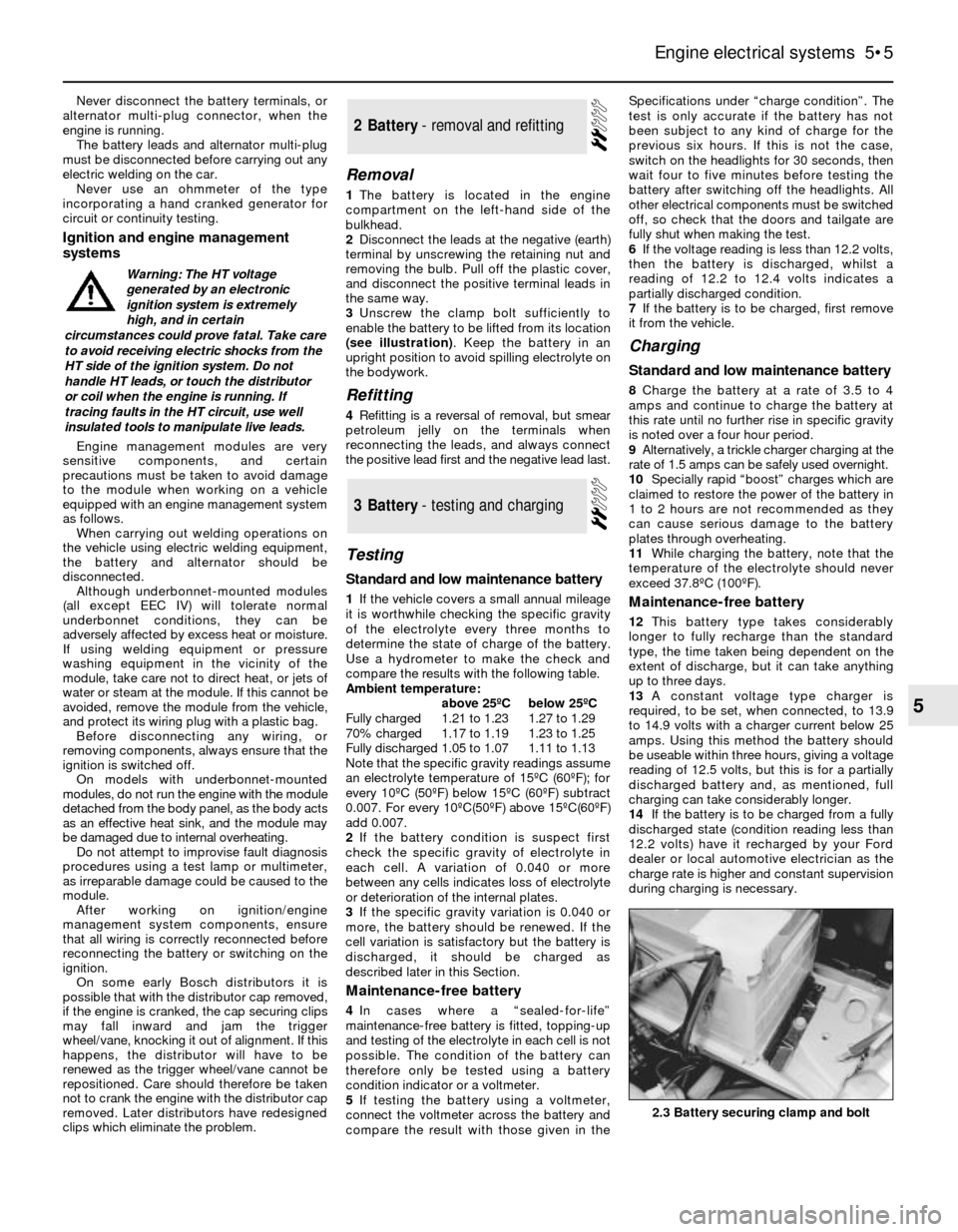
Never disconnect the battery terminals, or
alternator multi-plug connector, when the
engine is running.
The battery leads and alternator multi-plug
must be disconnected before carrying out any
electric welding on the car.
Never use an ohmmeter of the type
incorporating a hand cranked generator for
circuit or continuity testing.
Ignition and engine management
systems
Engine management modules are very
sensitive components, and certain
precautions must be taken to avoid damage
to the module when working on a vehicle
equipped with an engine management system
as follows.
When carrying out welding operations on
the vehicle using electric welding equipment,
the battery and alternator should be
disconnected.
Although underbonnet-mounted modules
(all except EEC IV) will tolerate normal
underbonnet conditions, they can be
adversely affected by excess heat or moisture.
If using welding equipment or pressure
washing equipment in the vicinity of the
module, take care not to direct heat, or jets of
water or steam at the module. If this cannot be
avoided, remove the module from the vehicle,
and protect its wiring plug with a plastic bag.
Before disconnecting any wiring, or
removing components, always ensure that the
ignition is switched off.
On models with underbonnet-mounted
modules, do not run the engine with the module
detached from the body panel, as the body acts
as an effective heat sink, and the module may
be damaged due to internal overheating.
Do not attempt to improvise fault diagnosis
procedures using a test lamp or multimeter,
as irreparable damage could be caused to the
module.
After working on ignition/engine
management system components, ensure
that all wiring is correctly reconnected before
reconnecting the battery or switching on the
ignition.
On some early Bosch distributors it is
possible that with the distributor cap removed,
if the engine is cranked, the cap securing clips
may fall inward and jam the trigger
wheel/vane, knocking it out of alignment. If this
happens, the distributor will have to be
renewed as the trigger wheel/vane cannot be
repositioned. Care should therefore be taken
not to crank the engine with the distributor cap
removed. Later distributors have redesigned
clips which eliminate the problem.
Removal
1The battery is located in the engine
compartment on the left-hand side of the
bulkhead.
2Disconnect the leads at the negative (earth)
terminal by unscrewing the retaining nut and
removing the bulb. Pull off the plastic cover,
and disconnect the positive terminal leads in
the same way.
3Unscrew the clamp bolt sufficiently to
enable the battery to be lifted from its location
(see illustration). Keep the battery in an
upright position to avoid spilling electrolyte on
the bodywork.
Refitting
4Refitting is a reversal of removal, but smear
petroleum jelly on the terminals when
reconnecting the leads, and always connect
the positive lead first and the negative lead last.
Testing
Standard and low maintenance battery
1If the vehicle covers a small annual mileage
it is worthwhile checking the specific gravity
of the electrolyte every three months to
determine the state of charge of the battery.
Use a hydrometer to make the check and
compare the results with the following table.
Ambient temperature:
above 25ºCbelow 25ºC
Fully charged1.21 to 1.231.27 to 1.29
70% charged1.17 to 1.191.23 to 1.25
Fully discharged1.05 to 1.071.11 to 1.13
Note that the specific gravity readings assume
an electrolyte temperature of 15ºC (60ºF); for
every 10ºC (50ºF) below 15ºC (60ºF) subtract
0.007. For every 10ºC(50ºF) above 15ºC(60ºF)
add 0.007.
2If the battery condition is suspect first
check the specific gravity of electrolyte in
each cell. A variation of 0.040 or more
between any cells indicates loss of electrolyte
or deterioration of the internal plates.
3If the specific gravity variation is 0.040 or
more, the battery should be renewed. If the
cell variation is satisfactory but the battery is
discharged, it should be charged as
described later in this Section.
Maintenance-free battery
4In cases where a “sealed-for-life”
maintenance-free battery is fitted, topping-up
and testing of the electrolyte in each cell is not
possible. The condition of the battery can
therefore only be tested using a battery
condition indicator or a voltmeter.
5If testing the battery using a voltmeter,
connect the voltmeter across the battery and
compare the result with those given in theSpecifications under “charge condition”. The
test is only accurate if the battery has not
been subject to any kind of charge for the
previous six hours. If this is not the case,
switch on the headlights for 30 seconds, then
wait four to five minutes before testing the
battery after switching off the headlights. All
other electrical components must be switched
off, so check that the doors and tailgate are
fully shut when making the test.
6If the voltage reading is less than 12.2 volts,
then the battery is discharged, whilst a
reading of 12.2 to 12.4 volts indicates a
partially discharged condition.
7If the battery is to be charged, first remove
it from the vehicle.
Charging
Standard and low maintenance battery
8Charge the battery at a rate of 3.5 to 4
amps and continue to charge the battery at
this rate until no further rise in specific gravity
is noted over a four hour period.
9Alternatively, a trickle charger charging at the
rate of 1.5 amps can be safely used overnight.
10Specially rapid “boost” charges which are
claimed to restore the power of the battery in
1 to 2 hours are not recommended as they
can cause serious damage to the battery
plates through overheating.
11While charging the battery, note that the
temperature of the electrolyte should never
exceed 37.8ºC (100ºF).
Maintenance-free battery
12This battery type takes considerably
longer to fully recharge than the standard
type, the time taken being dependent on the
extent of discharge, but it can take anything
up to three days.
13A constant voltage type charger is
required, to be set, when connected, to 13.9
to 14.9 volts with a charger current below 25
amps. Using this method the battery should
be useable within three hours, giving a voltage
reading of 12.5 volts, but this is for a partially
discharged battery and, as mentioned, full
charging can take considerably longer.
14If the battery is to be charged from a fully
discharged state (condition reading less than
12.2 volts) have it recharged by your Ford
dealer or local automotive electrician as the
charge rate is higher and constant supervision
during charging is necessary.
3Battery - testing and charging
2Battery - removal and refitting
Engine electrical systems 5•5
5
2.3 Battery securing clamp and bolt
Warning: The HT voltage
generated by an electronic
ignition system is extremely
high, and in certain
circumstances could prove fatal. Take care
to avoid receiving electric shocks from the
HT side of the ignition system. Do not
handle HT leads, or touch the distributor
or coil when the engine is running. If
tracing faults in the HT circuit, use well
insulated tools to manipulate live leads.
Page 9 of 24
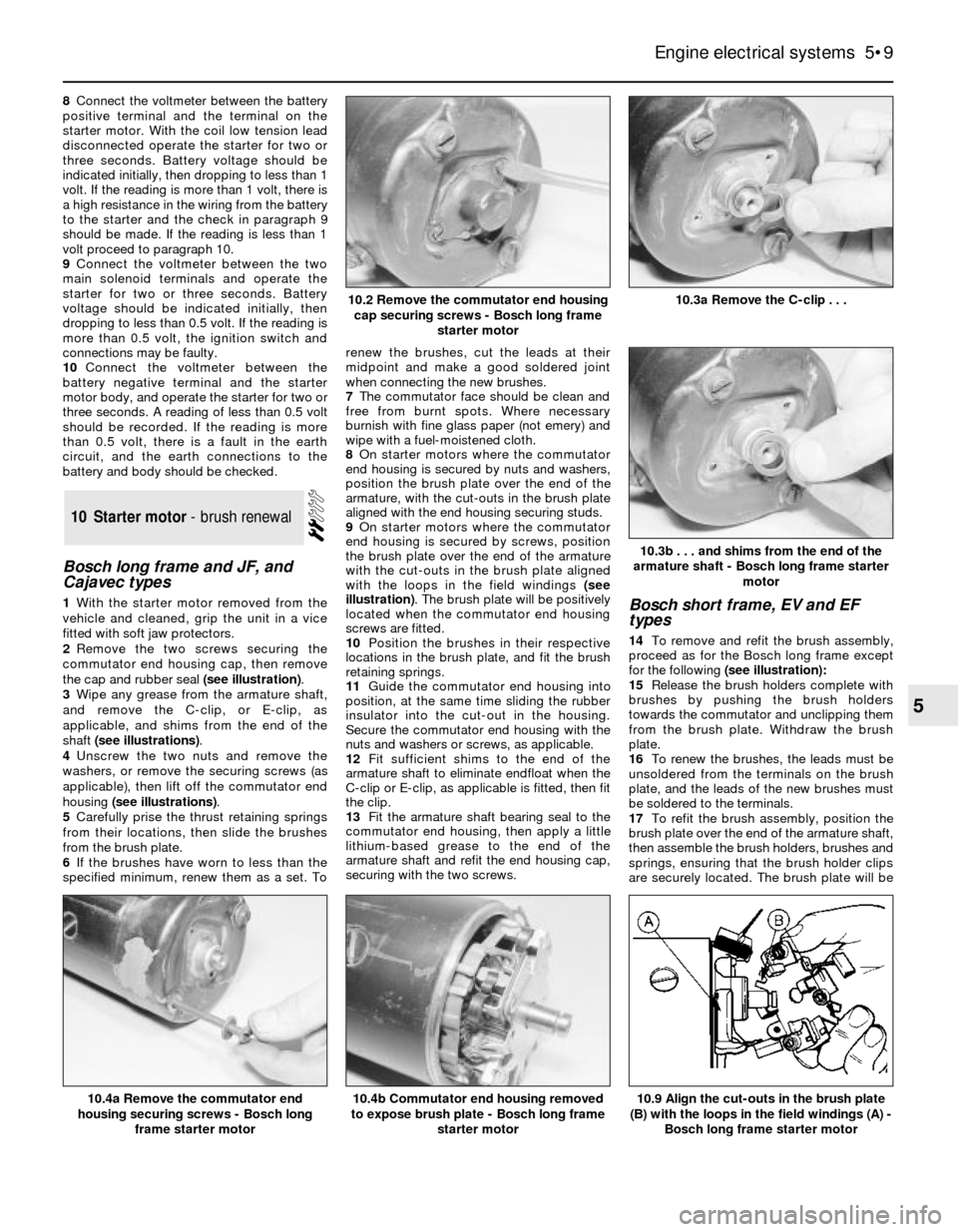
8Connect the voltmeter between the battery
positive terminal and the terminal on the
starter motor. With the coil low tension lead
disconnected operate the starter for two or
three seconds. Battery voltage should be
indicated initially, then dropping to less than 1
volt. If the reading is more than 1 volt, there is
a high resistance in the wiring from the battery
to the starter and the check in paragraph 9
should be made. If the reading is less than 1
volt proceed to paragraph 10.
9Connect the voltmeter between the two
main solenoid terminals and operate the
starter for two or three seconds. Battery
voltage should be indicated initially, then
dropping to less than 0.5 volt. If the reading is
more than 0.5 volt, the ignition switch and
connections may be faulty.
10Connect the voltmeter between the
battery negative terminal and the starter
motor body, and operate the starter for two or
three seconds. A reading of less than 0.5 volt
should be recorded. If the reading is more
than 0.5 volt, there is a fault in the earth
circuit, and the earth connections to the
battery and body should be checked.
Bosch long frame and JF, and
Cajavec types
1With the starter motor removed from the
vehicle and cleaned, grip the unit in a vice
fitted with soft jaw protectors.
2Remove the two screws securing the
commutator end housing cap, then remove
the cap and rubber seal (see illustration).
3Wipe any grease from the armature shaft,
and remove the C-clip, or E-clip, as
applicable, and shims from the end of the
shaft (see illustrations).
4Unscrew the two nuts and remove the
washers, or remove the securing screws (as
applicable), then lift off the commutator end
housing (see illustrations).
5Carefully prise the thrust retaining springs
from their locations, then slide the brushes
from the brush plate.
6If the brushes have worn to less than the
specified minimum, renew them as a set. Torenew the brushes, cut the leads at their
midpoint and make a good soldered joint
when connecting the new brushes.
7The commutator face should be clean and
free from burnt spots. Where necessary
burnish with fine glass paper (not emery) and
wipe with a fuel-moistened cloth.
8On starter motors where the commutator
end housing is secured by nuts and washers,
position the brush plate over the end of the
armature, with the cut-outs in the brush plate
aligned with the end housing securing studs.
9On starter motors where the commutator
end housing is secured by screws, position
the brush plate over the end of the armature
with the cut-outs in the brush plate aligned
with the loops in the field windings (see
illustration). The brush plate will be positively
located when the commutator end housing
screws are fitted.
10Position the brushes in their respective
locations in the brush plate, and fit the brush
retaining springs.
11Guide the commutator end housing into
position, at the same time sliding the rubber
insulator into the cut-out in the housing.
Secure the commutator end housing with the
nuts and washers or screws, as applicable.
12Fit sufficient shims to the end of the
armature shaft to eliminate endfloat when the
C-clip or E-clip, as applicable is fitted, then fit
the clip.
13Fit the armature shaft bearing seal to the
commutator end housing, then apply a little
lithium-based grease to the end of the
armature shaft and refit the end housing cap,
securing with the two screws.Bosch short frame, EV and EF
types
14To remove and refit the brush assembly,
proceed as for the Bosch long frame except
for the following(see illustration):
15Release the brush holders complete with
brushes by pushing the brush holders
towards the commutator and unclipping them
from the brush plate. Withdraw the brush
plate.
16To renew the brushes, the leads must be
unsoldered from the terminals on the brush
plate, and the leads of the new brushes must
be soldered to the terminals.
17To refit the brush assembly, position the
brush plate over the end of the armature shaft,
then assemble the brush holders, brushes and
springs, ensuring that the brush holder clips
are securely located. The brush plate will be
10Starter motor - brush renewal
Engine electrical systems 5•9
5
10.3b . . . and shims from the end of the
armature shaft - Bosch long frame starter
motor
10.9 Align the cut-outs in the brush plate
(B) with the loops in the field windings (A) -
Bosch long frame starter motor10.4b Commutator end housing removed
to expose brush plate - Bosch long frame
starter motor10.4a Remove the commutator end
housing securing screws - Bosch long
frame starter motor
10.3a Remove the C-clip . . .10.2 Remove the commutator end housing
cap securing screws - Bosch long frame
starter motor
Page 10 of 24
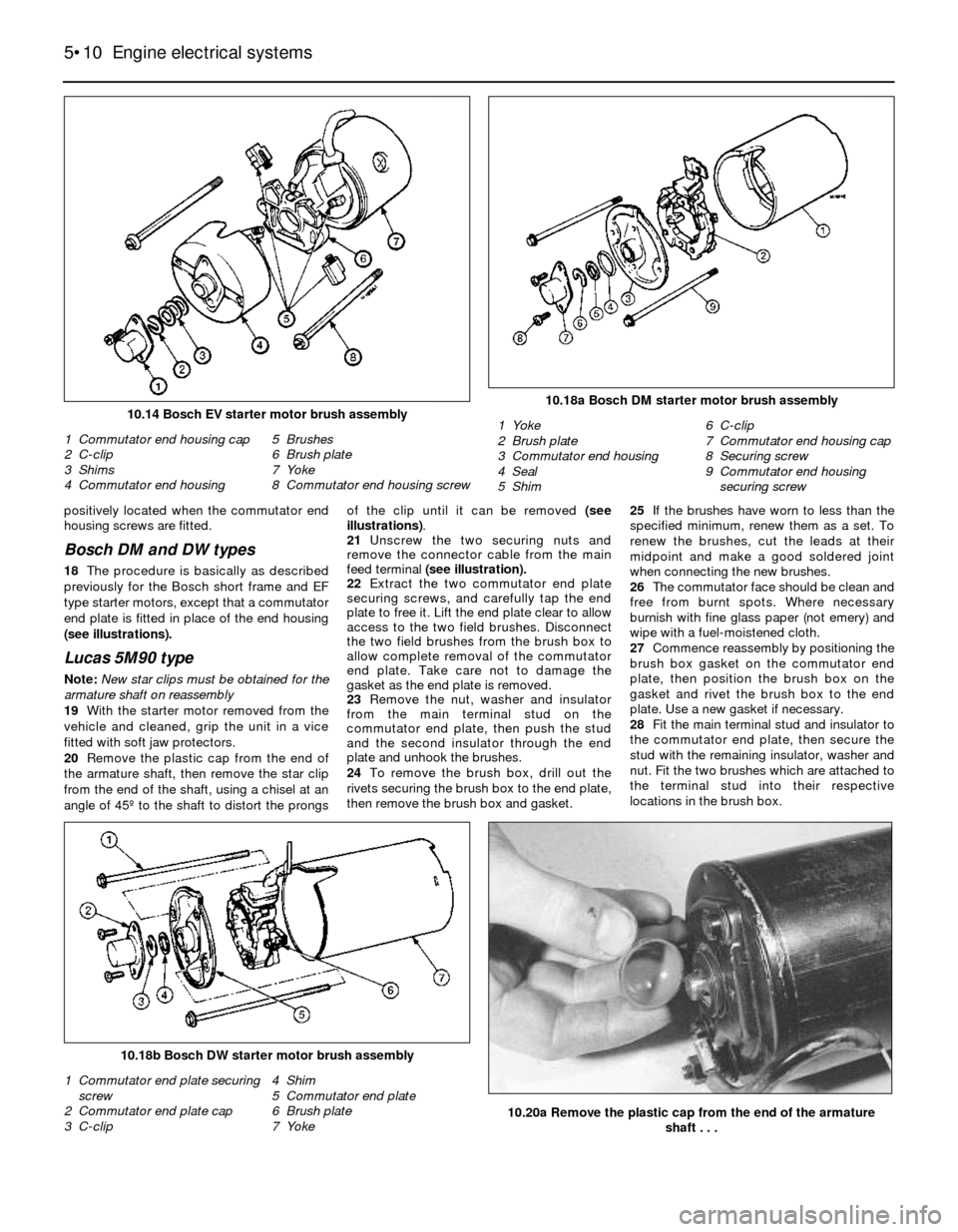
positively located when the commutator end
housing screws are fitted.
Bosch DM and DW types
18The procedure is basically as described
previously for the Bosch short frame and EF
type starter motors, except that a commutator
end plate is fitted in place of the end housing
(see illustrations).
Lucas 5M90 type
Note: New star clips must be obtained for the
armature shaft on reassembly
19With the starter motor removed from the
vehicle and cleaned, grip the unit in a vice
fitted with soft jaw protectors.
20Remove the plastic cap from the end of
the armature shaft, then remove the star clip
from the end of the shaft, using a chisel at an
angle of 45º to the shaft to distort the prongsof the clip until it can be removed (see
illustrations).
21Unscrew the two securing nuts and
remove the connector cable from the main
feed terminal (see illustration).
22Extract the two commutator end plate
securing screws, and carefully tap the end
plate to free it. Lift the end plate clear to allow
access to the two field brushes. Disconnect
the two field brushes from the brush box to
allow complete removal of the commutator
end plate. Take care not to damage the
gasket as the end plate is removed.
23Remove the nut, washer and insulator
from the main terminal stud on the
commutator end plate, then push the stud
and the second insulator through the end
plate and unhook the brushes.
24To remove the brush box, drill out the
rivets securing the brush box to the end plate,
then remove the brush box and gasket.25If the brushes have worn to less than the
specified minimum, renew them as a set. To
renew the brushes, cut the leads at their
midpoint and make a good soldered joint
when connecting the new brushes.
26The commutator face should be clean and
free from burnt spots. Where necessary
burnish with fine glass paper (not emery) and
wipe with a fuel-moistened cloth.
27Commence reassembly by positioning the
brush box gasket on the commutator end
plate, then position the brush box on the
gasket and rivet the brush box to the end
plate. Use a new gasket if necessary.
28Fit the main terminal stud and insulator to
the commutator end plate, then secure the
stud with the remaining insulator, washer and
nut. Fit the two brushes which are attached to
the terminal stud into their respective
locations in the brush box.
5•10Engine electrical systems
10.18a Bosch DM starter motor brush assembly
1 Yoke
2 Brush plate
3 Commutator end housing
4 Seal
5 Shim6 C-clip
7 Commutator end housing cap
8 Securing screw
9 Commutator end housing
securing screw
10.20a Remove the plastic cap from the end of the armature
shaft . . .
10.18b Bosch DW starter motor brush assembly
1 Commutator end plate securing
screw
2 Commutator end plate cap
3 C-clip4 Shim
5 Commutator end plate
6 Brush plate
7 Yoke
10.14 Bosch EV starter motor brush assembly
1 Commutator end housing cap
2 C-clip
3 Shims
4 Commutator end housing5 Brushes
6 Brush plate
7 Yoke
8 Commutator end housing screw
Page 13 of 24
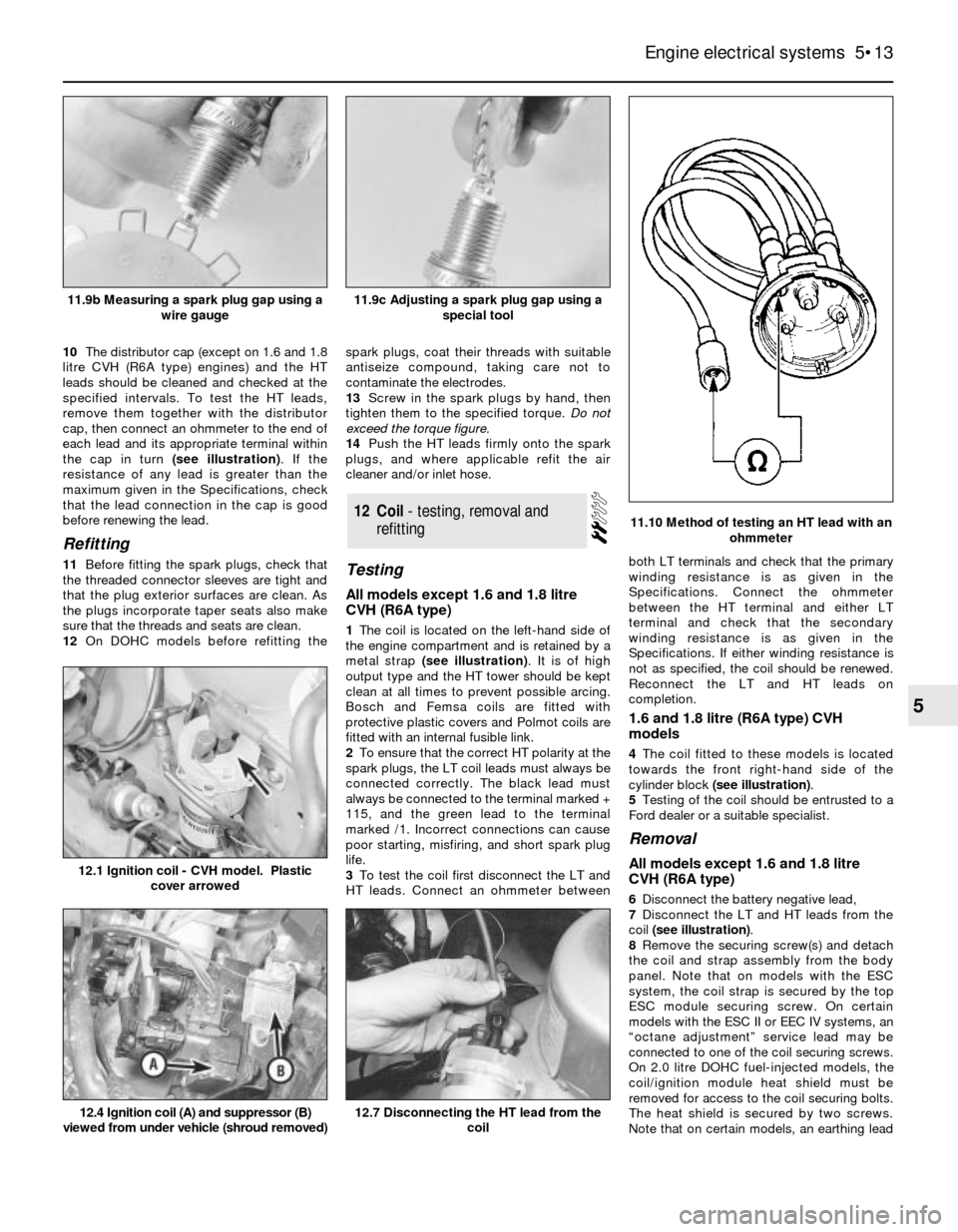
10The distributor cap (except on 1.6 and 1.8
litre CVH (R6A type) engines) and the HT
leads should be cleaned and checked at the
specified intervals. To test the HT leads,
remove them together with the distributor
cap, then connect an ohmmeter to the end of
each lead and its appropriate terminal within
the cap in turn (see illustration). If the
resistance of any lead is greater than the
maximum given in the Specifications, check
that the lead connection in the cap is good
before renewing the lead.
Refitting
11Before fitting the spark plugs, check that
the threaded connector sleeves are tight and
that the plug exterior surfaces are clean. As
the plugs incorporate taper seats also make
sure that the threads and seats are clean.
12On DOHC models before refitting thespark plugs, coat their threads with suitable
antiseize compound, taking care not to
contaminate the electrodes.
13Screw in the spark plugs by hand, then
tighten them to the specified torque. Do not
exceed the torque figure.
14Push the HT leads firmly onto the spark
plugs, and where applicable refit the air
cleaner and/or inlet hose.Testing
All models except 1.6 and 1.8 litre
CVH (R6A type)
1The coil is located on the left-hand side of
the engine compartment and is retained by a
metal strap (see illustration). It is of high
output type and the HT tower should be kept
clean at all times to prevent possible arcing.
Bosch and Femsa coils are fitted with
protective plastic covers and Polmot coils are
fitted with an internal fusible link.
2To ensure that the correct HT polarity at the
spark plugs, the LT coil leads must always be
connected correctly. The black lead must
always be connected to the terminal marked +
115, and the green lead to the terminal
marked /1. Incorrect connections can cause
poor starting, misfiring, and short spark plug
life.
3To test the coil first disconnect the LT and
HT leads. Connect an ohmmeter betweenboth LT terminals and check that the primary
winding resistance is as given in the
Specifications. Connect the ohmmeter
between the HT terminal and either LT
terminal and check that the secondary
winding resistance is as given in the
Specifications. If either winding resistance is
not as specified, the coil should be renewed.
Reconnect the LT and HT leads on
completion.
1.6 and 1.8 litre (R6A type) CVH
models
4The coil fitted to these models is located
towards the front right-hand side of the
cylinder block (see illustration).
5Testing of the coil should be entrusted to a
Ford dealer or a suitable specialist.
Removal
All models except 1.6 and 1.8 litre
CVH (R6A type)
6Disconnect the battery negative lead,
7Disconnect the LT and HT leads from the
coil (see illustration).
8Remove the securing screw(s) and detach
the coil and strap assembly from the body
panel. Note that on models with the ESC
system, the coil strap is secured by the top
ESC module securing screw. On certain
models with the ESC II or EEC IV systems, an
“octane adjustment” service lead may be
connected to one of the coil securing screws.
On 2.0 litre DOHC fuel-injected models, the
coil/ignition module heat shield must be
removed for access to the coil securing bolts.
The heat shield is secured by two screws.
Note that on certain models, an earthing lead
12Coil - testing, removal and
refitting
Engine electrical systems 5•13
5
11.10 Method of testing an HT lead with an
ohmmeter
12.4 Ignition coil (A) and suppressor (B)
viewed from under vehicle (shroud removed)12.7 Disconnecting the HT lead from the
coil
12.1 Ignition coil - CVH model. Plastic
cover arrowed
11.9c Adjusting a spark plug gap using a
special tool11.9b Measuring a spark plug gap using a
wire gauge
Page 17 of 24
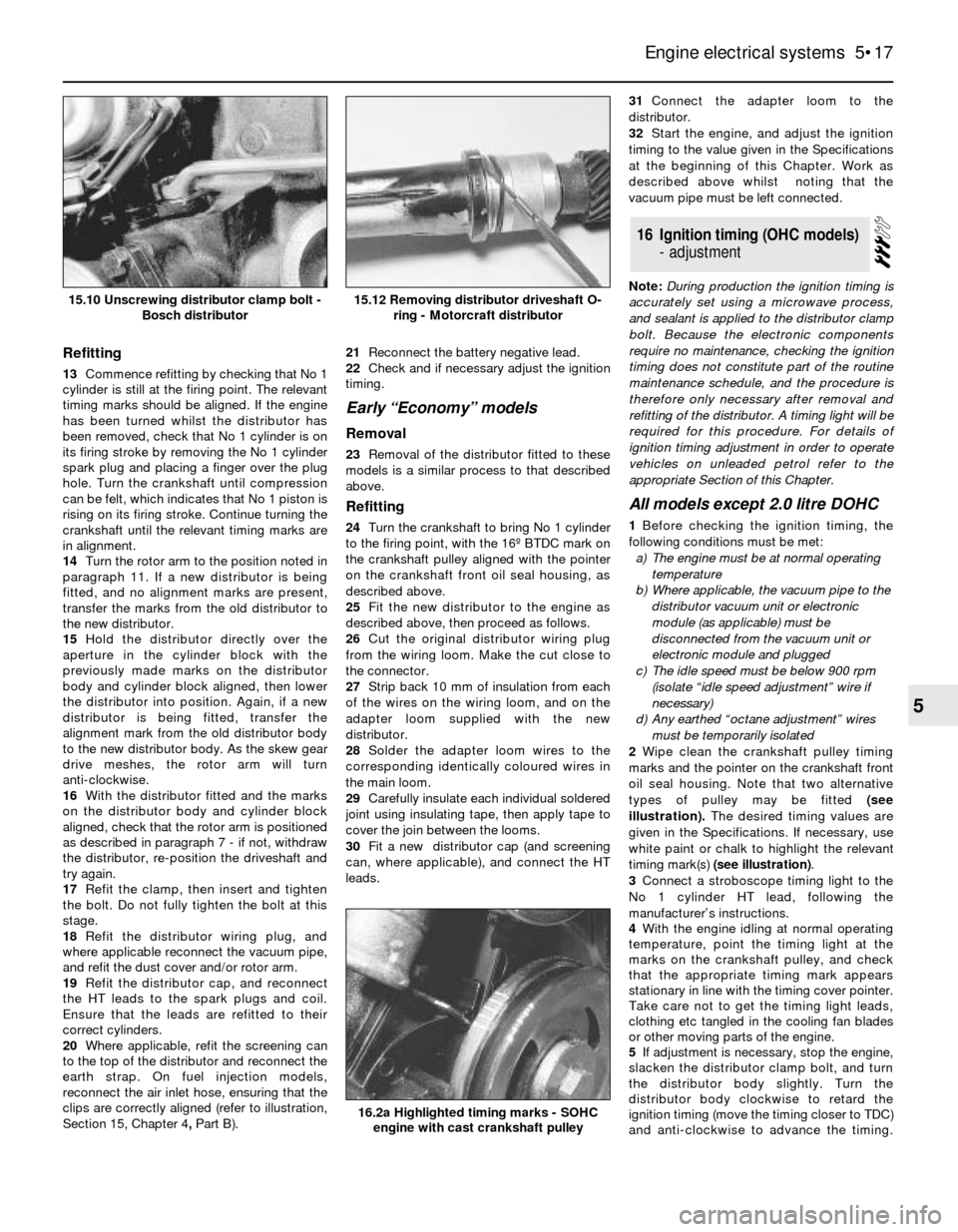
Refitting
13Commence refitting by checking that No 1
cylinder is still at the firing point. The relevant
timing marks should be aligned. If the engine
has been turned whilst the distributor has
been removed, check that No 1 cylinder is on
its firing stroke by removing the No 1 cylinder
spark plug and placing a finger over the plug
hole. Turn the crankshaft until compression
can be felt, which indicates that No 1 piston is
rising on its firing stroke. Continue turning the
crankshaft until the relevant timing marks are
in alignment.
14Turn the rotor arm to the position noted in
paragraph 11. If a new distributor is being
fitted, and no alignment marks are present,
transfer the marks from the old distributor to
the new distributor.
15Hold the distributor directly over the
aperture in the cylinder block with the
previously made marks on the distributor
body and cylinder block aligned, then lower
the distributor into position. Again, if a new
distributor is being fitted, transfer the
alignment mark from the old distributor body
to the new distributor body. As the skew gear
drive meshes, the rotor arm will turn
anti-clockwise.
16With the distributor fitted and the marks
on the distributor body and cylinder block
aligned, check that the rotor arm is positioned
as described in paragraph 7 -if not, withdraw
the distributor, re-position the driveshaft and
try again.
17Refit the clamp, then insert and tighten
the bolt. Do not fully tighten the bolt at this
stage.
18Refit the distributor wiring plug, and
where applicable reconnect the vacuum pipe,
and refit the dust cover and/or rotor arm.
19Refit the distributor cap, and reconnect
the HT leads to the spark plugs and coil.
Ensure that the leads are refitted to their
correct cylinders.
20Where applicable, refit the screening can
to the top of the distributor and reconnect the
earth strap. On fuel injection models,
reconnect the air inlet hose, ensuring that the
clips are correctly aligned (refer to illustration,
Section 15, Chapter 4, PartB).21Reconnect the battery negative lead.
22Check and if necessary adjust the ignition
timing.
Early “Economy” models
Removal
23Removal of the distributor fitted to these
models is a similar process to that described
above.
Refitting
24Turn the crankshaft to bring No 1 cylinder
to the firing point, with the 16º BTDC mark on
the crankshaft pulley aligned with the pointer
on the crankshaft front oil seal housing, as
described above.
25Fit the new distributor to the engine as
described above, then proceed as follows.
26Cut the original distributor wiring plug
from the wiring loom. Make the cut close to
the connector.
27Strip back 10 mm of insulation from each
of the wires on the wiring loom, and on the
adapter loom supplied with the new
distributor.
28Solder the adapter loom wires to the
corresponding identically coloured wires in
the main loom.
29Carefully insulate each individual soldered
joint using insulating tape, then apply tape to
cover the join between the looms.
30Fit a new distributor cap (and screening
can, where applicable), and connect the HT
leads.31Connect the adapter loom to the
distributor.
32Start the engine, and adjust the ignition
timing to the value given in the Specifications
at the beginning of this Chapter. Work as
described above whilst noting that the
vacuum pipe must be left connected.
Note: During production the ignition timing is
accurately set using a microwave process,
and sealant is applied to the distributor clamp
bolt. Because the electronic components
require no maintenance, checking the ignition
timing does not constitute part of the routine
maintenance schedule, and the procedure is
therefore only necessary after removal and
refitting of the distributor. A timing light will be
required for this procedure. For details of
ignition timing adjustment in order to operate
vehicles on unleaded petrol refer to the
appropriate Section of this Chapter.
All models except 2.0 litre DOHC
1Before checking the ignition timing, the
following conditions must be met:
a)The engine must be at normal operating
temperature
b)Where applicable, the vacuum pipe to the
distributor vacuum unit or electronic
module (as applicable) must be
disconnected from the vacuum unit or
electronic module and plugged
c)The idle speed must be below 900 rpm
(isolate “idle speed adjustment” wire if
necessary)
d)Any earthed “octane adjustment” wires
must be temporarily isolated
2Wipe clean the crankshaft pulley timing
marks and the pointer on the crankshaft front
oil seal housing. Note that two alternative
types of pulley may be fitted (see
illustration).The desired timing values are
given in the Specifications. If necessary, use
white paint or chalk to highlight the relevant
timing mark(s) (see illustration).
3Connect a stroboscope timing light to the
No 1 cylinder HT lead, following the
manufacturer’s instructions.
4With the engine idling at normal operating
temperature, point the timing light at the
marks on the crankshaft pulley, and check
that the appropriate timing mark appears
stationary in line with the timing cover pointer.
Take care not to get the timing light leads,
clothing etc tangled in the cooling fan blades
or other moving parts of the engine.
5If adjustment is necessary, stop the engine,
slacken the distributor clamp bolt, and turn
the distributor body slightly. Turn the
distributor body clockwise to retard the
ignition timing (move the timing closer to TDC)
and anti-clockwise to advance the timing.
16Ignition timing (OHC models)
- adjustment
Engine electrical systems 5•17
5
15.12 Removing distributor driveshaft O-
ring - Motorcraft distributor15.10 Unscrewing distributor clamp bolt -
Bosch distributor
16.2a Highlighted timing marks - SOHC
engine with cast crankshaft pulley
Page 19 of 24
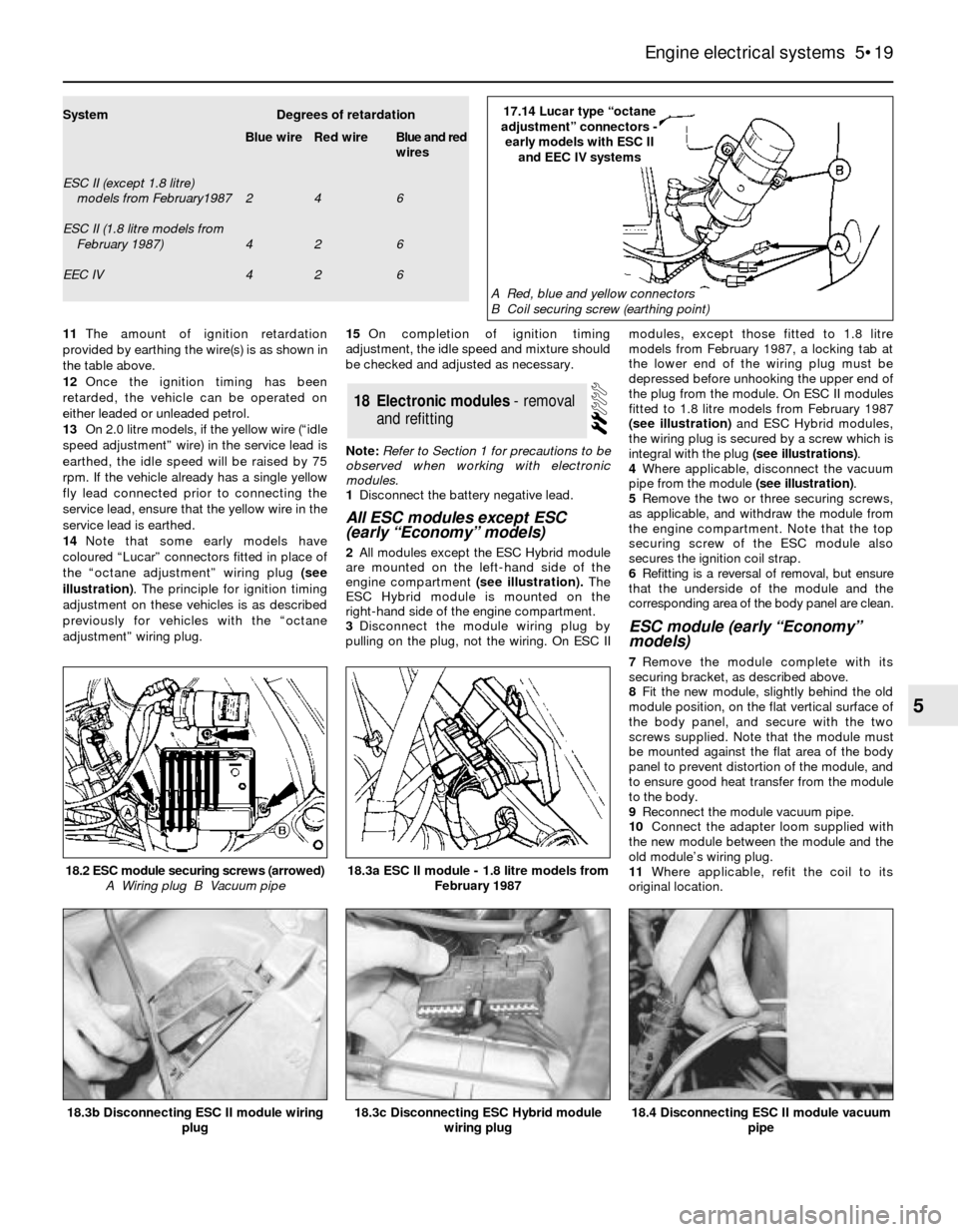
11The amount of ignition retardation
provided by earthing the wire(s) is as shown in
the table above.
12Once the ignition timing has been
retarded, the vehicle can be operated on
either leaded or unleaded petrol.
13On 2.0 litre models, if the yellow wire (“idle
speed adjustment” wire) in the service lead is
earthed, the idle speed will be raised by 75
rpm. If the vehicle already has a single yellow
fly lead connected prior to connecting the
service lead, ensure that the yellow wire in the
service lead is earthed.
14Note that some early models have
coloured “Lucar” connectors fitted in place of
the “octane adjustment” wiring plug (see
illustration). The principle for ignition timing
adjustment on these vehicles is as described
previously for vehicles with the “octane
adjustment” wiring plug.15On completion of ignition timing
adjustment, the idle speed and mixture should
be checked and adjusted as necessary.
Note: Refer to Section 1 for precautions to be
observed when working with electronic
modules.
1Disconnect the battery negative lead.
All ESC modules except ESC
(early “Economy” models)
2All modules except the ESC Hybrid module
are mounted on the left-hand side of the
engine compartment(see illustration).The
ESC Hybrid module is mounted on the
right-hand side of the engine compartment.
3Disconnect the module wiring plug by
pulling on the plug, not the wiring. On ESC IImodules, except those fitted to 1.8 litre
models from February 1987, a locking tab at
the lower end of the wiring plug must be
depressed before unhooking the upper end of
the plug from the module. On ESC II modules
fitted to 1.8 litre models from February 1987
(see illustration)and ESC Hybrid modules,
the wiring plug is secured by a screw which is
integral with the plug (see illustrations).
4Where applicable, disconnect the vacuum
pipe from the module (see illustration).
5Remove the two or three securing screws,
as applicable, and withdraw the module from
the engine compartment. Note that the top
securing screw of the ESC module also
secures the ignition coil strap.
6Refitting is a reversal of removal, but ensure
that the underside of the module and the
corresponding area of the body panel are clean.
ESC module (early “Economy”
models)
7Remove the module complete with its
securing bracket, as described above.
8Fit the new module, slightly behind the old
module position, on the flat vertical surface of
the body panel, and secure with the two
screws supplied. Note that the module must
be mounted against the flat area of the body
panel to prevent distortion of the module, and
to ensure good heat transfer from the module
to the body.
9Reconnect the module vacuum pipe.
10Connect the adapter loom supplied with
the new module between the module and the
old module’s wiring plug.
11Where applicable, refit the coil to its
original location.
18Electronic modules - removal
and refitting
Engine electrical systems 5•19
5
18.4 Disconnecting ESC II module vacuum
pipe18.3c Disconnecting ESC Hybrid module
wiring plug18.3b Disconnecting ESC II module wiring
plug
18.2 ESC module securing screws (arrowed)
A Wiring plug B Vacuum pipe18.3a ESC II module - 1.8 litre models from
February 1987
SystemDegrees of retardation
Blue wireRed wireBlue and red
wires
ESC II (except 1.8 litre)
models from February1987246
ESC II (1.8 litre models from
February 1987)426
EEC IV42617.14 Lucar type “octane
adjustment” connectors -
early models with ESC II
and EEC IV systems
A Red, blue and yellow connectors
B Coil securing screw (earthing point)
Page 20 of 24
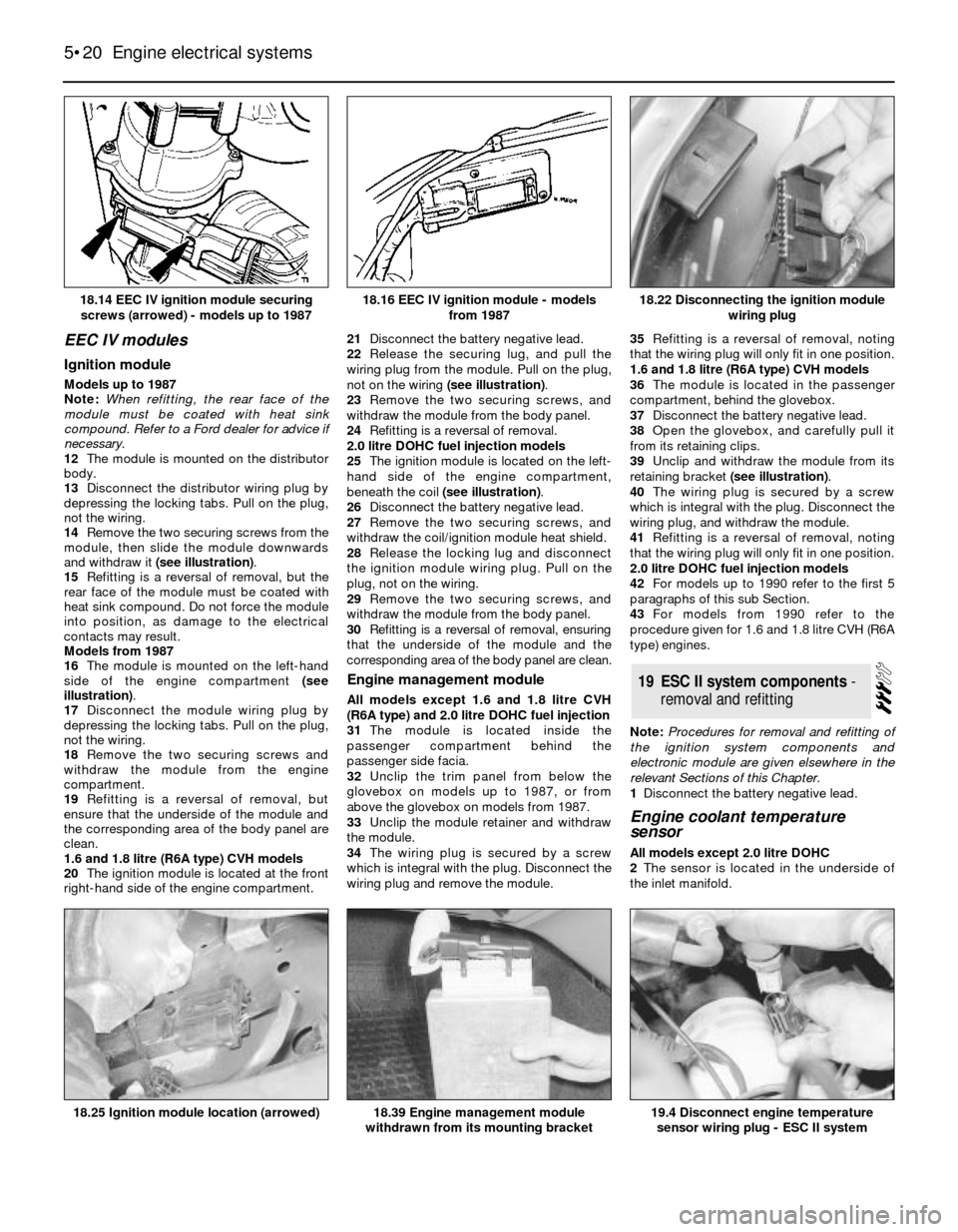
EEC IV modules
Ignition module
Models up to 1987
Note: When refitting, the rear face of the
module must be coated with heat sink
compound. Refer to a Ford dealer for advice if
necessary.
12The module is mounted on the distributor
body.
13Disconnect the distributor wiring plug by
depressing the locking tabs. Pull on the plug,
not the wiring.
14Remove the two securing screws from the
module, then slide the module downwards
and withdraw it (see illustration).
15Refitting is a reversal of removal, but the
rear face of the module must be coated with
heat sink compound. Do not force the module
into position, as damage to the electrical
contacts may result.
Models from 1987
16The module is mounted on the left-hand
side of the engine compartment (see
illustration).
17Disconnect the module wiring plug by
depressing the locking tabs. Pull on the plug,
not the wiring.
18Remove the two securing screws and
withdraw the module from the engine
compartment.
19Refitting is a reversal of removal, but
ensure that the underside of the module and
the corresponding area of the body panel are
clean.
1.6 and 1.8 litre (R6A type) CVH models
20The ignition module is located at the front
right-hand side of the engine compartment. 21Disconnect the battery negative lead.
22Release the securing lug, and pull the
wiring plug from the module. Pull on the plug,
not on the wiring (see illustration).
23Remove the two securing screws, and
withdraw the module from the body panel.
24Refitting is a reversal of removal.
2.0 litre DOHC fuel injection models
25The ignition module is located on the left-
hand side of the engine compartment,
beneath the coil (see illustration).
26Disconnect the battery negative lead.
27Remove the two securing screws, and
withdraw the coil/ignition module heat shield.
28Release the locking lug and disconnect
the ignition module wiring plug. Pull on the
plug, not on the wiring.
29Remove the two securing screws, and
withdraw the module from the body panel.
30Refitting is a reversal of removal, ensuring
that the underside of the module and the
corresponding area of the body panel are clean.
Engine management module
All models except 1.6 and 1.8 litre CVH
(R6A type) and 2.0 litre DOHC fuel injection
31The module is located inside the
passenger compartment behind the
passenger side facia.
32Unclip the trim panel from below the
glovebox on models up to 1987, or from
above the glovebox on models from 1987.
33Unclip the module retainer and withdraw
the module.
34The wiring plug is secured by a screw
which is integral with the plug. Disconnect the
wiring plug and remove the module.35Refitting is a reversal of removal, noting
that the wiring plug will only fit in one position.
1.6 and 1.8 litre (R6A type) CVH models
36The module is located in the passenger
compartment, behind the glovebox.
37Disconnect the battery negative lead.
38Open the glovebox, and carefully pull it
from its retaining clips.
39Unclip and withdraw the module from its
retaining bracket (see illustration).
40The wiring plug is secured by a screw
which is integral with the plug. Disconnect the
wiring plug, and withdraw the module.
41Refitting is a reversal of removal, noting
that the wiring plug will only fit in one position.
2.0 litre DOHC fuel injection models
42For models up to 1990 refer to the first 5
paragraphs of this sub Section.
43For models from 1990 refer to the
procedure given for 1.6 and 1.8 litre CVH (R6A
type) engines.
Note: Procedures for removal and refitting of
the ignition system components and
electronic module are given elsewhere in the
relevant Sections of this Chapter.
1Disconnect the battery negative lead.
Engine coolant temperature
sensor
All models except 2.0 litre DOHC
2The sensor is located in the underside of
the inlet manifold.
19ESC II system components -
removal and refitting
5•20Engine electrical systems
18.14 EEC IV ignition module securing
screws (arrowed) - models up to 198718.22 Disconnecting the ignition module
wiring plug
19.4 Disconnect engine temperature
sensor wiring plug - ESC II system18.39 Engine management module
withdrawn from its mounting bracket18.25 Ignition module location (arrowed)
18.16 EEC IV ignition module - models
from 1987
Page 21 of 24
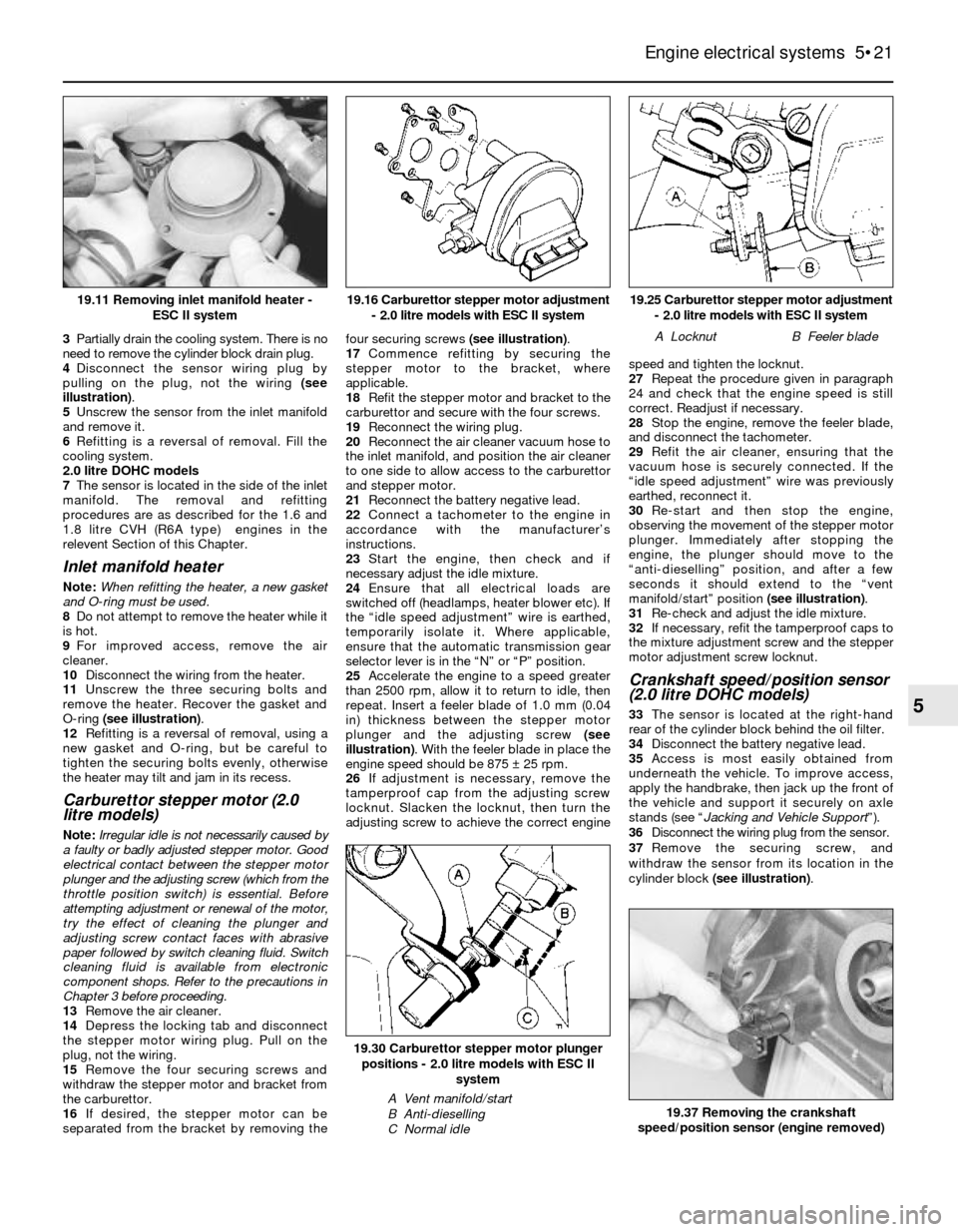
3Partially drain the cooling system. There is no
need to remove the cylinder block drain plug.
4Disconnect the sensor wiring plug by
pulling on the plug, not the wiring (see
illustration).
5Unscrew the sensor from the inlet manifold
and remove it.
6Refitting is a reversal of removal. Fill the
cooling system.
2.0 litre DOHC models
7The sensor is located in the side of the inlet
manifold. The removal and refitting
procedures are as described for the 1.6 and
1.8 litre CVH (R6A type) engines in the
relevent Section of this Chapter.
Inlet manifold heater
Note: When refitting the heater, a new gasket
and O-ring must be used.
8Do not attempt to remove the heater while it
is hot.
9For improved access, remove the air
cleaner.
10Disconnect the wiring from the heater.
11Unscrew the three securing bolts and
remove the heater. Recover the gasket and
O-ring (see illustration).
12Refitting is a reversal of removal, using a
new gasket and O-ring, but be careful to
tighten the securing bolts evenly, otherwise
the heater may tilt and jam in its recess.
Carburettor stepper motor (2.0
litre models)
Note: Irregular idle is not necessarily caused by
a faulty or badly adjusted stepper motor. Good
electrical contact between the stepper motor
plunger and the adjusting screw (which from the
throttle position switch) is essential. Before
attempting adjustment or renewal of the motor,
try the effect of cleaning the plunger and
adjusting screw contact faces with abrasive
paper followed by switch cleaning fluid. Switch
cleaning fluid is available from electronic
component shops. Refer to the precautions in
Chapter 3 before proceeding.
13Remove the air cleaner.
14Depress the locking tab and disconnect
the stepper motor wiring plug. Pull on the
plug, not the wiring.
15Remove the four securing screws and
withdraw the stepper motor and bracket from
the carburettor.
16If desired, the stepper motor can be
separated from the bracket by removing thefour securing screws (see illustration).
17Commence refitting by securing the
stepper motor to the bracket, where
applicable.
18Refit the stepper motor and bracket to the
carburettor and secure with the four screws.
19Reconnect the wiring plug.
20Reconnect the air cleaner vacuum hose to
the inlet manifold, and position the air cleaner
to one side to allow access to the carburettor
and stepper motor.
21Reconnect the battery negative lead.
22Connect a tachometer to the engine in
accordance with the manufacturer’s
instructions.
23Start the engine, then check and if
necessary adjust the idle mixture.
24Ensure that all electrical loads are
switched off (headlamps, heater blower etc). If
the “idle speed adjustment” wire is earthed,
temporarily isolate it. Where applicable,
ensure that the automatic transmission gear
selector lever is in the “N” or “P” position.
25Accelerate the engine to a speed greater
than 2500 rpm, allow it to return to idle, then
repeat. Insert a feeler blade of 1.0 mm (0.04
in) thickness between the stepper motor
plunger and the adjusting screw (see
illustration). With the feeler blade in place the
engine speed should be 875 ±25 rpm.
26If adjustment is necessary, remove the
tamperproof cap from the adjusting screw
locknut. Slacken the locknut, then turn the
adjusting screw to achieve the correct enginespeed and tighten the locknut.
27Repeat the procedure given in paragraph
24 and check that the engine speed is still
correct. Readjust if necessary.
28Stop the engine, remove the feeler blade,
and disconnect the tachometer.
29Refit the air cleaner, ensuring that the
vacuum hose is securely connected. If the
“idle speed adjustment” wire was previously
earthed, reconnect it.
30Re-start and then stop the engine,
observing the movement of the stepper motor
plunger. Immediately after stopping the
engine, the plunger should move to the
“anti-dieselling” position, and after a few
seconds it should extend to the “vent
manifold/start” position (see illustration).
31Re-check and adjust the idle mixture.
32If necessary, refit the tamperproof caps to
the mixture adjustment screw and the stepper
motor adjustment screw locknut.
Crankshaft speed/position sensor
(2.0 litre DOHC models)
33The sensor is located at the right-hand
rear of the cylinder block behind the oil filter.
34Disconnect the battery negative lead.
35Access is most easily obtained from
underneath the vehicle. To improve access,
apply the handbrake, then jack up the front of
the vehicle and support it securely on axle
stands (see “Jacking and Vehicle Support”).
36Disconnect the wiring plug from the sensor.
37Remove the securing screw, and
withdraw the sensor from its location in the
cylinder block (see illustration).
Engine electrical systems 5•21
5
19.25 Carburettor stepper motor adjustment
- 2.0 litre models with ESC II system
A LocknutB Feeler blade
19.37 Removing the crankshaft
speed/position sensor (engine removed)
19.30 Carburettor stepper motor plunger
positions - 2.0 litre models with ESC II
system
A Vent manifold/start
B Anti-dieselling
C Normal idle
19.16 Carburettor stepper motor adjustment
- 2.0 litre models with ESC II system19.11 Removing inlet manifold heater -
ESC II system